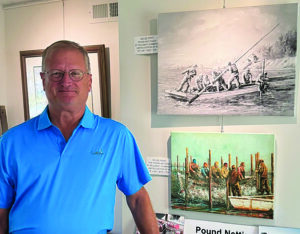(Editor’s note: DeeDee Wood is the owner of Black Cat Curiosities, an online antiques research and sales venue.)

Tilghman Watermen’s Museum President Chuck Powers led a tour of rooms with multiple artifacts, displays and information regarding Tilghman Island history, the watermen who worked and lived there, and their families. (Photo by DeeDee Wood)
Driving out to Tilghman Island, with a long, curvy road and twists and turns that offer views of the Chesapeake Bay and surrounding tributaries, you can feel like you are driving back in time, to a place where watermen made their living off of the mighty Chesapeake and left behind artifacts and history for us to study and present, even to this day.
Chuck Powers, President of the Tilghman Watermen’s Museum, took time on a sunny afternoon on the island to show me around the museum, which is also called the Lee House, or a “W” house, a structure built around 1890-1900.
It is only one of seven surviving homes with this design, structured for air flow and movement.
The museum is the main house that represents many artifacts and information, and there are grounds outside that have more Tilghman and watermen history interpretation, with a few out buildings involved in that presentation. The property is situated on the main street through town, Tilghman Island Road, with interesting presentation at first glance, due to the unique structure of the “W” design of the house. There are tools and nautical displays outside, as well as historical markers and informational plaques as you walk the grounds, soaking in the atmosphere of history.
Upon first entering the museum, Powers showed me the several rooms downstairs with multiple artifacts, displays and information regarding Tilghman Island history, the watermen who worked and lived there, and their families.
There is a portrait gallery of watermen, donated by the George S. Webb Family, “Honoring Watermen,” the plaque reads. Powers also showed me paintings and artistic works done by a famous artist and waterman of the area, Bill Cummings.
The museum’s website states, “Bill Cummings was a Tilghman native whose art recalls a time lost on Tilghman. Painting from only his memory, his images show us a Tilghman many of us have never seen.”
Visitors can find boat models made by Bill Sommers and Vincent Haddaway, among others, examples of watermen tools of the trade, videos and presentation panels explaining the craft of the watermen, their history, family lineage and more.
There is also a unique oral history program at the museum, that captures to video the stories and memories of the history and watermen of this area.
When asked of the mission statement or main goals of the museum, Chuck Powers conveyed, “it is important to save and present the heritage of the Tilghman Island watermen and their families. In 20 years, we want people to come here and still have access to the history of the watermen.”
Upstairs in the museum are additional, interesting displays, such as, but not limited to, oyster and harvesting industry and history, ship name panel fronts, local decoys, and interesting displays of ancient artifacts found in and around the island, some archeological finds, and some items found and brought in to the museum.
There are displays both inside and out regarding ways in which the Bay was harvested, such as netting, tongues, dredging and various techniques of the people who called this island and the surrounding areas home. The mix of art and narrative aids in the immersion of history of atmosphere of this quaint town and the people who lived and worked here.
The organization hosts several fundraising events throughout the year, as well as membership drives and annual appeals, and has special Tilghman-unique Christmas presentations in the museum. There is also a robust collection of items to buy in their gift shop, such as localized, Tilghman-themed holiday ornaments, totes, media and more to consider.
The museum is located at 6031 Tilghman Island Rd., in Tilghman, Maryland, and is open 10am-3pm Saturdays and Sundays. For other information and details of their entire operation, displays history and more, visit their website at www.tilghmanmuseum.org, or call 410-320-0300.



